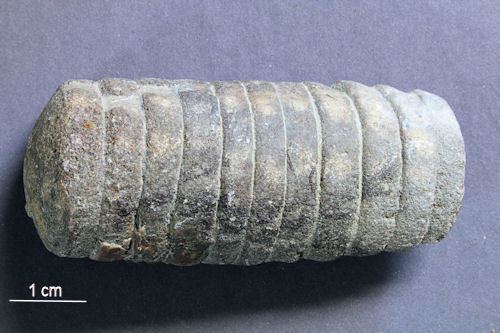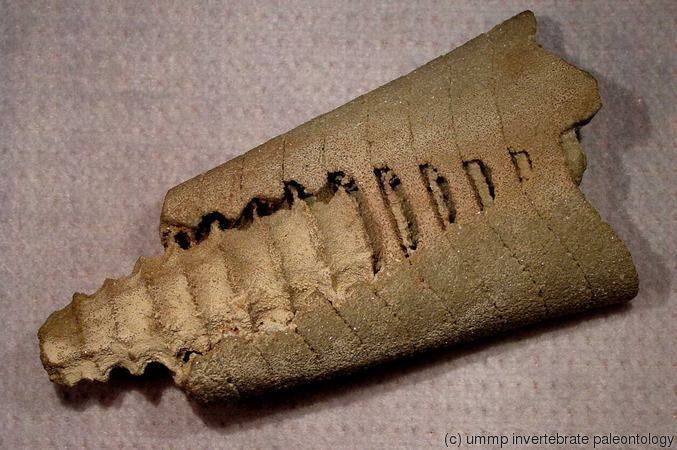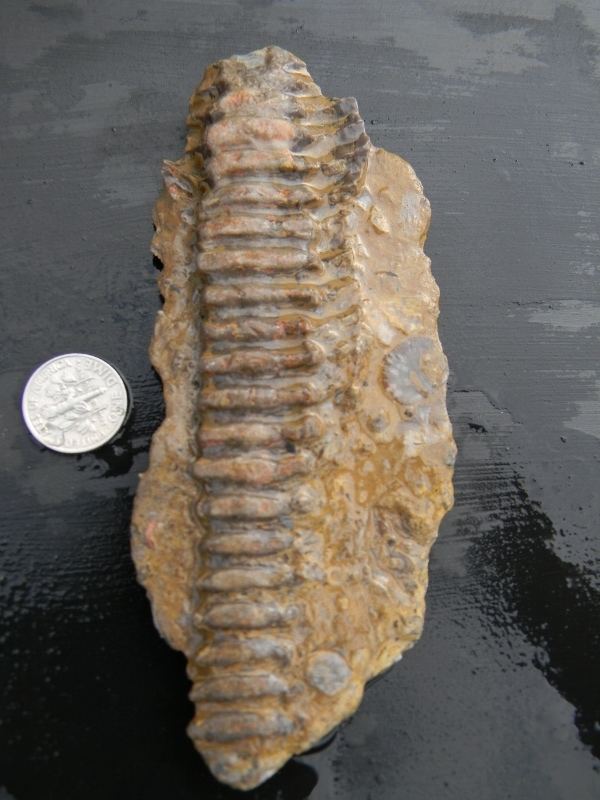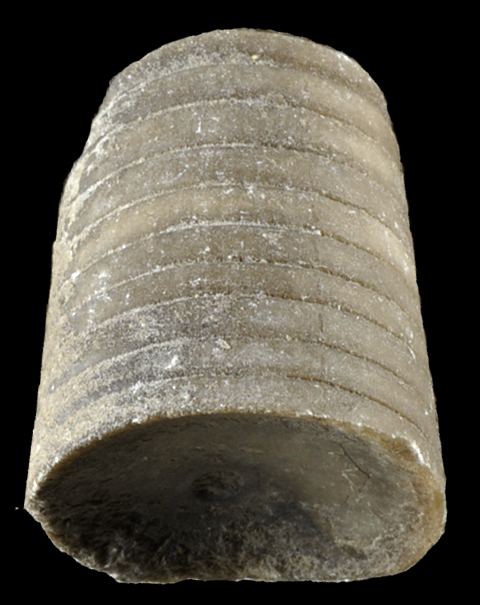Rank Genus Subclass Nautiloid | ||
 | ||
Similar Armenoceras, Nautiloid, Endoceras, Armenoceratidae, Kionoceras | ||
Actinoceras is the principal and root genus of the Actinoceratidae, a major family in the Actinocerida, that lived during the Middle and Late Ordovician.
Contents

Morphology

Actinoceras are generally large, with typically straight shells reaching a meter or so in length (about 3 ft), with a blunt apex, and usually with a circular to subcircular cross section. .
Shell characteristics

The shells of Actinoceras are generally straight and long, although some are breviconic. Some are fusiform with the diameter decreasing from the anterior end of the phragmocone toward the aperture. Chambers are short and contain cameral deposits which are more concentrated apically and ventrally. Septa are close spaced, sutures are mostly transverse. The siphuncle, which varies in proportion to the size of the shell among species, is ventral, but not on the ventral margin. (Flower 1957)
Siphucle

The siphuncle, which is ventral of the center but away from the ventral margin, is generally large and composed of segments that are expanded into the chambers, more so than in Ormoceras or Lambeoceras but not as much as in Armenoceras. (Flower 1957) The diameter typically becomes smaller with respect to that of the shell in the forward or anterior part of the phragmocone. Septal necks are long with wide cyrtochoanitic to recumbent brims. Connecting rings are thin.(Teichert 1964)
Canal system

The canal system within the siphuncle in Arctinocers is of the singe arc type wherein the radial canals branch off the central canal near the septal openings and sweep back and out, connecting to the parispatium in the preceding segments at their broadest expansion. This type is also found in the derivatives (descendants) of Actinoceras, e.g. Lambeoceras, in some Armenoceras, Nybyoceras, and in Gonioceras. (Flower 1957). The parispatium is a narrow opening or seam that forms between the inside of the connecting rings and the endosiphunclar deposits that grow forward and back from the region of the septal foremina.
Species

About 45 species have been described from North America, including Greenland and the Canadian Arctic with Actinoceras margaretae, A. aequale, and A. gradatum the earliest known, coming from the lower Blackriveran Loweville fm of Ottawa. Actinoceras concavum from the Ssuyan of southern Manchuria is most similar to Actinoceras centrale from the Chaumont of New York.
Phylogeny

Actinoceras is one of seven known genera in the Family Actinoceratidae.(Teichert 1964) Actinoceras is thought to have given rise to such genera as Kochoceras and Paractinoceras in the Actinoceratidae and to Lambeoceras of the Lambeoceratidae. The derivation of Actinoceras may be in an early Armenoceras or perhaps from an early Nybyoceras, also part of the Armenoceratidae.
Related genera
The following actinoceratid genera are closely related to Actinoceras although differing in various details.
Kochoceras, named by Troedsson, 1926, is a middle to upper Ordovician actinocerid similar overall to Actinoceras but with the shell flattened on the venter and with the siphuncle in broad contact with the ventral margin. Kochoceras was first discovered in northern Greenland, which during the Ordovician was near equatorial.
Leurothoceras, named by Foeste, 1921, is an actincerid with a flattened shell and narrower siphincle than in Actinoceras. Siphuncel segments in this genus tend to become strongly elongated in the mature part of the phragmocone.
Paractinoceras, named by Hyatt, in Zittel 1900, is a long, straight, slender-shelled actinocerid with the siphuncle segments in the early stage expanded as in Actinoceras, but becoming narrow in the later stages as in Ormoceras. Paractinoceras has been found in North America in Manitoba, and in Russia in Siberia.
Saffordoceras, named by Foeste and Teichert in 1930, is an actinicerid with a ventrally flattened shell, subventral siphuncle with short segments, and sutures with broad shallow ventral lobes and narrower lateral saddles. Saffordoceras comes from the Middle Ordovician of eastern North America.
Troostoceras, also named by Foeste & Teichert in 1930, is similar to Actinoceras but with a slightly cyroconic and endogastric shell. It is known from the Middle Ordovician of eastern North America and Siberia.
